GREECE: 2004
 Thursday, April 2, 2015 at 11:57AM
Thursday, April 2, 2015 at 11:57AM Greece had been much in the news in 2004 for having hosted the Olympic Games that summer, and the hours spent watching coverage of the Games had whetted our interest in going there. The hike we signed up for promised variety: gentle walking in the Pindos Mountains, relaxation on a Greek island, and as an optional “extension,” an assault on Mount Olympus. The games were finished by the time we arrived in Athens in September, but our taxi driver must not have known that, and appeared to be under the impression that a Gold Medal was awaiting him if he could set a new world record covering the distance between the airport and the city. He certainly gave it his best shot.
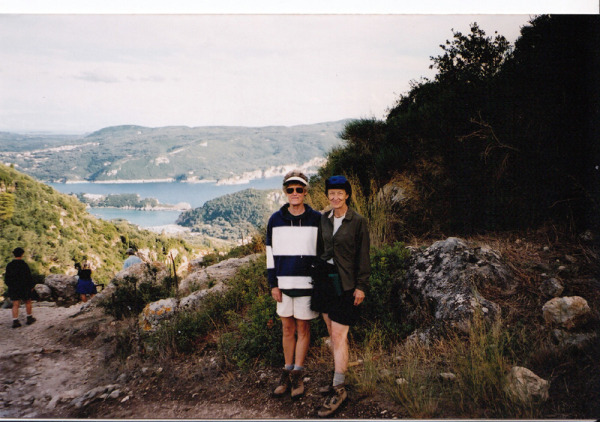 Suzy and Ellie
Suzy and Ellie
We met our group later that evening for dinner in the restaurant on the roof of the hotel. One always hopes to make a good first impression, but this time we may have come across as slack-jawed imbeciles because when we stepped out onto the roof we found ourselves staring straight at the floodlit Acropolis on its hill across the city – surely one of the most breathtaking sights in the world. Polite conversation with our new companions was put on hold while we drank it in, but eventually we got around to the introductions. We were a group of fifteen. Our guide was a very tall Greek, and some of the tales he told were constructed along similar lines. (He once, so his story went, broke his leg while skiing alone and was forced to break one ski, use the two pieces as a splint, ski down on his one good leg, and then walk 4 hours to civilization.) It was immediately obvious that he enjoyed his food, and we were soon to discover that he liked to savor his food, too. Lunches especially could turn into long affairs, but none of us minded because the food was wonderful almost everywhere we went. (Or, quite possibly, we were only taken to places that offered wonderful food.)
A short flight the next day took us to Ioannina, the largest city of the prefecture of Epirus, in northwestern Greece. After a short tour of the historical highlights and a long lunch we climbed into two vans for the drive to Tsepelova, one of the 44 tiny villages that make up Zagoria, in the Pindos Mountains. The villages were originally settled by Slavs (“Zagoria” derives from a Slavic word meaning “behind the mountains”), sheepherders and subsistence farmers. For centuries the only connection between one village and the next was by footpath and one of the graceful stone bridges that are the hallmark of the region.
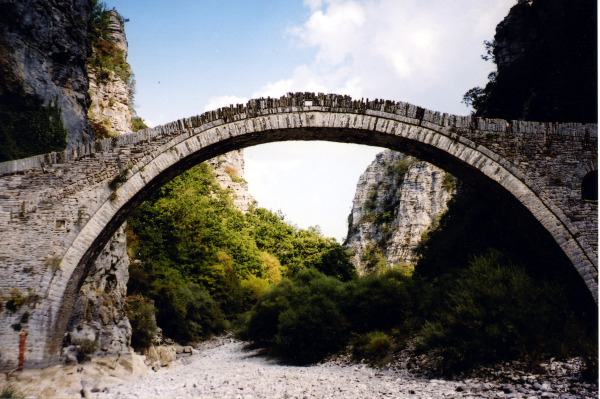 Plakadidas Bridge
Plakadidas Bridge
Now there are roads, but despite that there is little opportunity to entice young people to remain. One village we visited had a grand total of four year-round residents; its somewhat larger and more densely populated neighbor boasted ten. Tourism is their main hope for the future, but luckily for us, it was not far advanced when we were there. We did a short walk around the quaint village of Tsepelova before joining the rest of the group for an al fresco dinner of sausages, meatballs, french fries, yogurt, feta, potato cakes and salad. And baklava for those who could still manage it. Then a briefing by our guide on the history of the area, and bed.
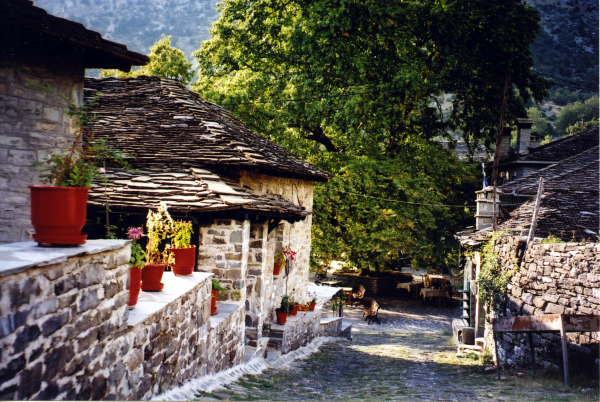 Tsepelova Village
Tsepelova Village
The next five days were spent exploring the tiny villages of stone houses: Vradeto, until the 1970s only accessible by way of about 100 steps built into the wall of a canyon; Kipi, with its picturesque triple-arched stone bridge; Vitsa, some of whose walls date from 2500 BC.; the two named Papingo, Megalo and Mikro (big and little, although those are relative terms).
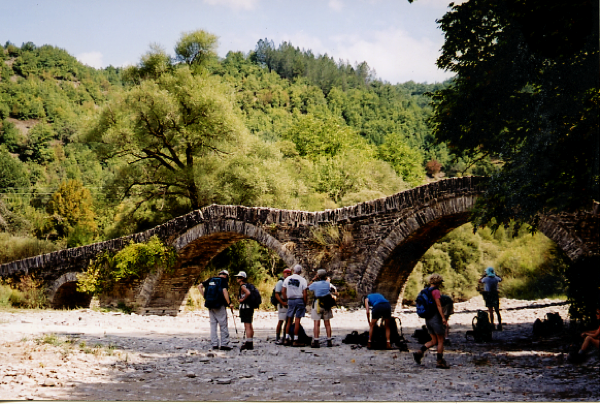 Bridge at Kipi
Bridge at Kipi
Our most dramatic hike was down into the Vikos Gorge. With walls rising more than 3,400 feet, it is second only to the Grand Canyon in depth. We walked for several hours among the rocks and boulders at the bottom of the gorge without seeing another human being.
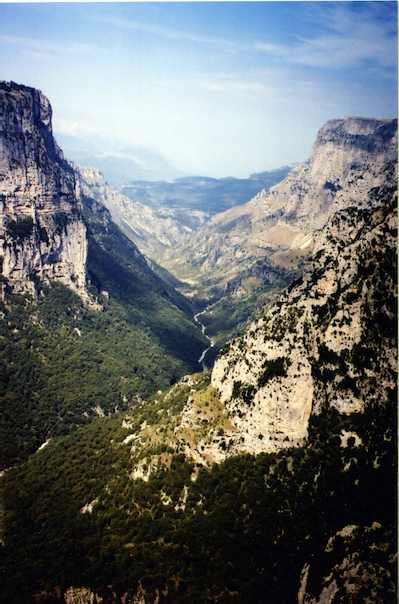 Vikos Gorge
Vikos Gorge
Higher up was the Monastery of Saint Paraskevi, founded in 1413 and built at the very edge of the gorge. A terrifyingly narrow ledge cut into the rock face of the gorge leads to a number of caves where persecuted Christians sought refuge during Ottoman times. Given a choice between crossing that ledge and converting, we would have sided with the Ottomans.
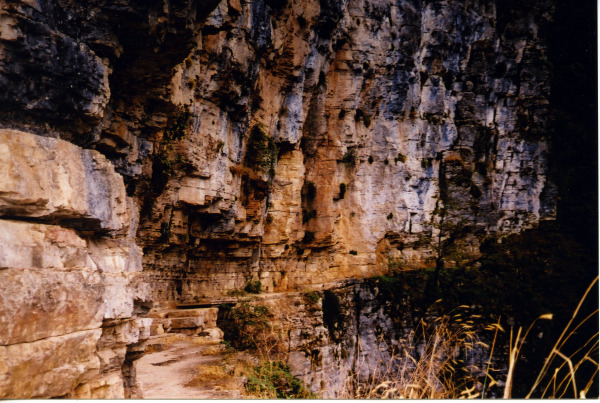 Narrow ledge leading to caves at Paraskevi Monastary
Narrow ledge leading to caves at Paraskevi Monastary
On another day we walked up to the Astraka Refuge, first through forest, then scrub, and then above the treeline to the dramatically situated refuge. It was among the cleanest we've ever seen; outside, however, the weather was turning filthy: freezing cold, with thunderstorms and lightning threatening.
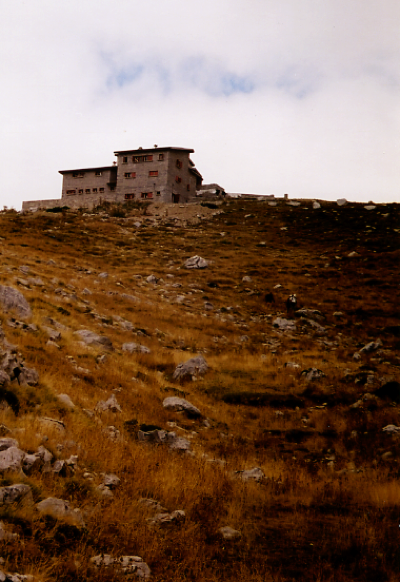 Astraka Refuge
Astraka Refuge
Dragon Lake, our intended destination, was nixed by our guide, and we made our way back down to our hotel, where, luckily, one of us offered a free clinic that evening for the several owners of sore feet. (Ellie would like it known that although she has no medical license, she has not been sued yet; how many real doctors can make that claim in our litigious society?)
The island on which we were to relax was Corfu. It was a long way west of where we were, and Mount Olympus an even longer way in the opposite direction, so we were destined to see a lot of Greece from our bus. (Reminder: read those pre-departure notes carefully!)
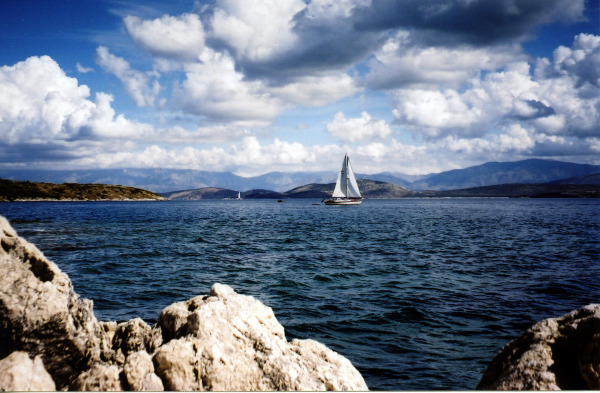 Corfu
Corfu
On the way to Igoumenitsa and the ferry to Corfu we stopped to visit the impressive amphitheater at Dodona, whose oracle is considered to be even older than that of Delphi. We had lunch at the port while awaiting the ferry, getting so distracted by the fresh-caught calamari, shrimp and smelt that we missed the one ferry we were meant to take and had to wait for a later one for the hour-and-a-half ride to Corfu.
The blue sky we had confidently expected to be spreading out over our Greek island had been preempted during the night by a howling gale and torrential rains, with no let up in sight come daybreak. A planned hike was ruled out because the footing would be too dangerous, so that day in Corfu was, alas, a literal and a meteorological washout. The second day was an improvement, and we took a fine cliff and shore walk, passing some pretty grand mansions along the way. Our sharp-eyed guide told us that several years earlier, leading another group, he had recognized the Royal Yacht at anchor offshore, put two and two together and concluded that Charles and Camilla must be not far away. That was confirmed when several military guards tried to stop him and his group from walking across the shore in front of a certain house, ordering them to take a long detour in another direction. That didn't go over well with our guide, and he pulled out his cell phone and announced that unless he and his group were allowed to continue in the direction they wished to go, every paparazzo on Corfu would know within minutes that “people of interest” were holed up at a soon-to-be-disclosed location belonging to a certain high-profile businessman. That got him a grudging “Alright, just go on through, but go quickly, please.”
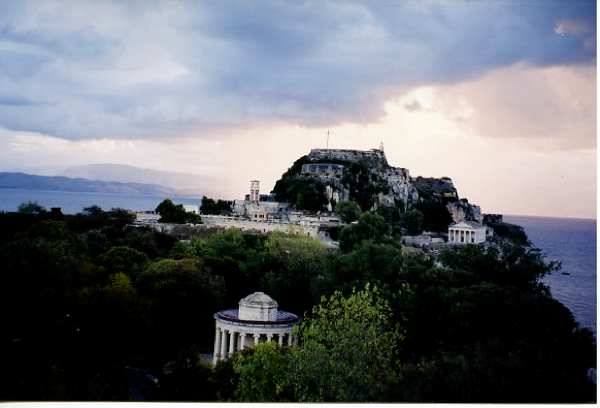 Old Fort on Corfu
Old Fort on Corfu
Nine of us had signed on for the extension climb of Mount Olympus, inconveniently located a long day's drive east from where we were. The only interesting sights on the way were the monasteries atop the sheer rock pinnacles at Meteora. They were closed by the time we got to them, and although we wouldn't have had time for a visit in any case (it takes a full day to do them justice), they are certainly worth a prolonged gawk.
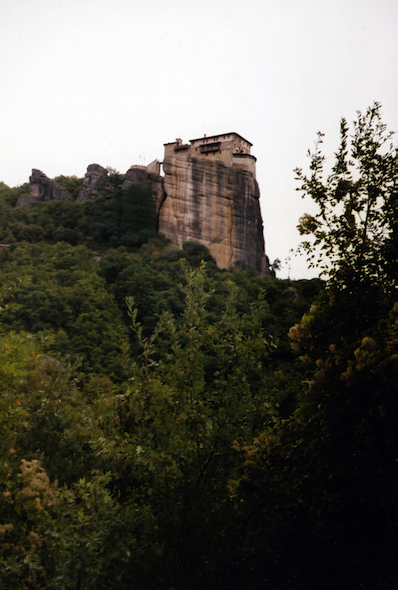 Meteora Monastery
Meteora Monastery
The base camp for climbing Mount Olympus is the town of Litochoro, near the Aegean Sea. We checked into our modest hotel, and the next morning jettisoned from our backpacks anything not absolutely necessary for the two days we would be on the mountain. We made room for the tiny packs of playing cards that have seen us through many a boring hour, but they were the only luxury we allowed ourselves. From the trailhead of Prionia we climbed up through forest for about three hours, passing stark reminders of the power of the avalanches that are not uncommon there. In one gully every one of the huge trees had been toppled like matchsticks and lay topsy-turvy on the ground like a giant game of Pick-up-Sticks. There were some healthy belladonna bushes along the way. One was surrounded by a small fence and there was a prominent sign "Do Not Eat". A couple of berries or a single leaf would be enough to kill an adult.
Eventually we arrived at “Refuge A.” It was clean and well maintained, and we were greeted by an elderly housekeeper who barked at us: “Take off your boots and put on your sleepers”. Ellie was obediently pulling on her long-johns before the mispronunciation dawned on her. There were bedrooms of varying sizes for guests of a wide range of nationalities, and there was a dormitory for guides. Our guide was keeping an eye on the weather, and after we'd had lunch (soup or pasta) he ruled out an attempt at the summit that day. It was enveloped in fog and very windy. The itinerary had anticipated this, and given us two days on the mountain, so we took the ruling in stride and anticipated a pleasant afternoon playing cards in the dining room, where there was a nice fire going. That was until we noticed, to our dismay, a large sign on the wall: “CARD PLAYING IS NOT ALLOWED.” Incredulous, we tried the second dining room; same notice. We whined to our guide, who until now had been able to make all things possible, but he explained that it is an iron-clad rule of the Hellenic Alpine Society. Apparently Greeks get a bit too enthusiastic when they get hold of playing cards; money starts to change hands, and in no time at all they become rowdy, and then violent. (They forbid cards and yet they give them driver's licenses. It makes no sense.) In desperation we even suggested playing in our bedroom with the door shut and sheets over our heads, but he stood firm. He managed to divert our attention for a while by leading us on a short hike just up to cloud level before heading back to the refuge. There, faced with nothing to do until dinner time except read stacks of Greek ferry schedules, we decided on anarchy. Luckily for us, our guide was occupied elsewhere, possibly making supplications to Zeus for better weather the next day. We organized an illegal and hilarious round of Scotch rummy in a small vestibule in another building; forbidden pleasures are so sweet.
Dinner was a repeat of lunch with the addition of meatballs. Then it was a quick douse with ice-cold water (there was no heat in the refuge), into our sleeping sacks and under the heavy blankets that had been provided by the refuge before the generator shut down at 10 pm sharp, plunging the refuge and its contents into pitch darkness.
Our guide's prayers were answered when we awoke to a brilliant and cloudless sky. The word was Go, and after a simple breakfast of bread and coffee, go we did. The guide set a brisk pace because he rightly predicted that clouds would roll in again by midday. A few in the group turned back, and the last hour over scree was tiring. But it was not technical climbing, and at last we arrived at Scala, one of the three summits of the mountain.
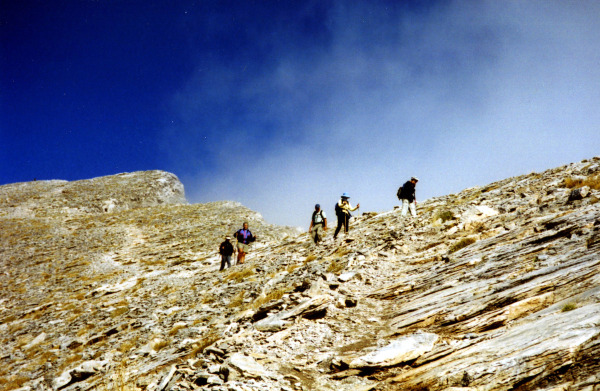 Climbing Mt. Olympus
Climbing Mt. Olympus
The other two are Mytikas and Scolio; Mystika is 18 meters higher than Scala and Scolio, but it was never on our agenda because it requires ropes and climbing experience. Scala was good enough for us. We had never before climbed a mountain that close to a sea, and the views down to the Aegean were spectacular. It was unfortunate that the one camera we had with us chose that moment to die and that the spare batteries we had thoughtfully brought from home had been thoughtlessly left in Litochoro so as not to add weight, but those things happen, particularly to people like us who don't always anticipate wisely. Suzy was more preoccupied with the realization that she was standing atop Mount Olympus on the day after what would have been her late husband's 80th birthday, not the birthday itself, as she had expected. Her being a day late would not have surprised him.
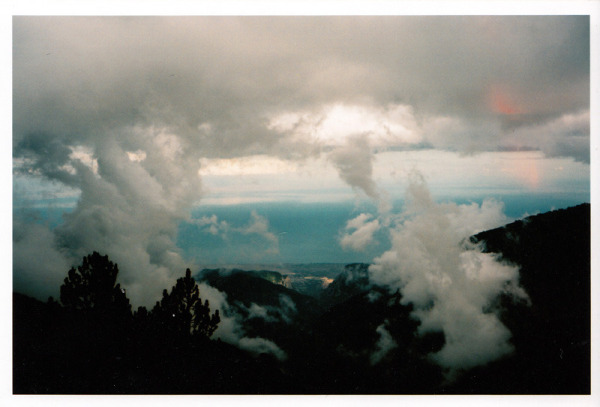 View toward the Aegean during the ascent of Mt. Olympus
View toward the Aegean during the ascent of Mt. Olympus
We stopped a last time at the refuge for lunch before continuing down to Litochoro. It was a long descent – easier on the lungs than the ascent, but hard on the knees. There was a farewell dinner that night and a drive to the airport in Thessaloniki the next morning for our flight to Athens. We were allowing ourselves extra time there to “do” Athens, and by the time we were to leave for home we had become so proficient with the public transportation system that we were able to prolong our life expectancy by not taking a taxi but confidently hopping onto the subway from the city to the airport.
click here to see a gallery of the photos

Reader Comments